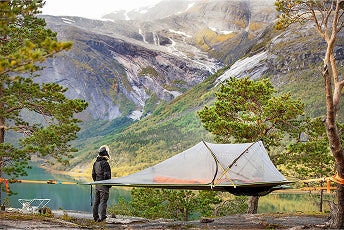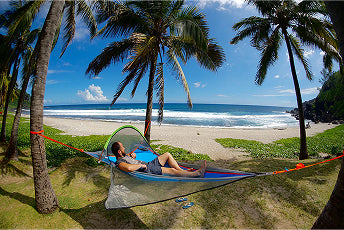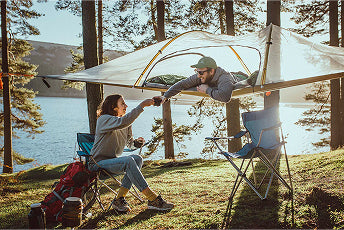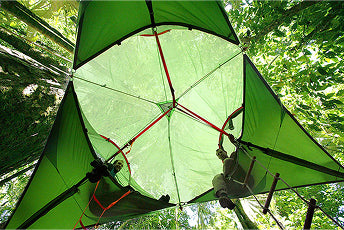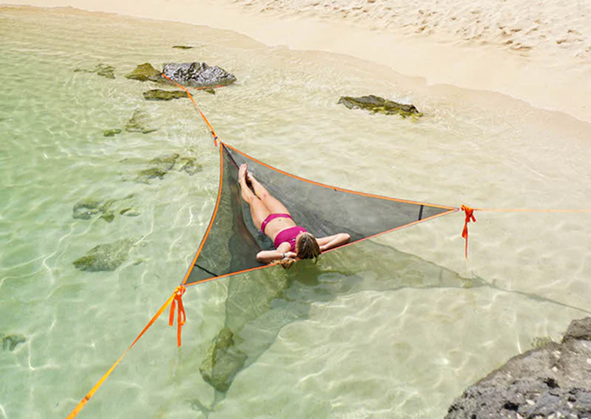How To ‘Leave No Trace’ While Tree Tent and Hammock Camping
When overnighting, leaving no trace means removing signs showing where your tent or hammock was. If your tent created an impression in the dirt, take a moment to erase it. Make the setting look as natural as when you found it (or better). When it comes to hammock camping, the main danger is leaving marks on trees which can damage the tree and, in extreme cases, even kill it.
Tentsile recommends using Tree Wraps which come as standard with every Tentsile Tree Tent and Giant Hammock. These minimise the impact to the tree by ensuring bark and the fragile cambium layer just beneath isn’t damaged.

Sticking to the ‘Leave No Trace’ Principles
The 7 Principles of Leave No Trace are simple and fairly easy to remember. Anyone using wilderness areas or parks should adhere to the 7 principles.
In the case of campfires, some areas require use of a fire pan to ensure that there is zero trace of ashes or burnt wood. Respecting wildlife means no feeding of the bears, not leaving food out, and not bothering animals. While taunting a buffalo so you can get a good photo shoot is obviously idiotic, every year a tourist in Yellowstone gets charged and several people have died this way.

Avoid disturbing your environment
When it comes to other campers, it’s just common sense to respect the boundaries of other people when on the trail, in a campsite, or on waterways.
The two principles some of us don’t always remember are to tread gently and avoid disturbing the flora and other parts of ecosystems (including rocks!). There is no need to stray off trail, as it damages sometimes highly delicate ecosystems. By the same token, don’t grab a piece of crystal or pick flowers – remember that every person who walks where you are may pick a flower and pretty soon there are none for others to enjoy.
Each wilderness area has its own specific Leave No Trace principles. In caves, the ethos can seem extreme, as cavers are taught not to touch cave walls with fingertips (the oils can kill the microflora) and avoid leaving even a crumb of food (it can quickly turn into a bloom of mold).

Why it’s important to stick to the principles
The "Leave No Trace" principles are important because they:
- Protect the Environment: By minimizing our impact, we safeguard ecosystems, wildlife habitats, and natural beauty.
- Maintain Wilderness Appeal: These principles keep outdoor areas pristine and true to their untouched character.
- Safeguard History and Culture: Respecting cultural and historical sites preserves their value for future generations.
- Prevent Trail Damage: Sticking to established paths prevents erosion and reduces the need for costly repairs.
- Ensure Access for All: Responsible behavior prevents overcrowding and access limitations.
- Educate About Responsibility: Practicing these principles teaches environmental consciousness.
- Ensure Long-Term Sustainability: We ensure ongoing outdoor recreation opportunities by protecting nature.
Leave No Trace promotes responsible outdoor enjoyment while safeguarding natural spaces.
‘Leave No Trace’ should be every camper’s mantra
Leave No Trace can seem extreme to those who haven’t done much camping. Kids, especially, have to learn what is acceptable and what is not when spending time in the forest, desert, swamp or seaside. Camping in a tent or hammock, or even glamping in a yurt, is the perfect opportunity to practice and teach Leave No Trace.
Leave No Trace should be every camper’s mantra, whether spending a night beneath the stars in remote wilderness or overnighting in a well-used state park. Trail users, kayakers and anyone spending time in the great outdoors also needs to follow proper outdoors etiquette.

The Leave No Trace credo, is a set of ethical rules to preserve the wilderness for its own sake, and for the sake of the next traveler (who could be you). No camper wants to find a remote backcountry grove of trees that’s been slashed by an over-eager hammock user or trashed by an inconsiderate group of beer drinkers.
Campers’ etiquette means leaving your camp spot as nice (or nicer) than you found it. Even cairns and half-burned logs are a problem because they loudly announce, “humans were here.”

